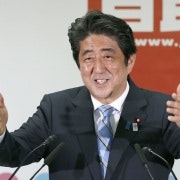The continuing struggles of Abenomics
Ever since the yen dropped nearly 6 per cent against the dollar last month, the Abe administration has been scrambling to limit the slide or mitigate its effects. Prime Minister Shinzo Abe and his advisers are well aware that a weaker yen will squeeze household consumption and business balance sheets just as the economy struggles to overcome its consumption-tax hangover.
Ultimately, the recent yen weakness shows just how much work remains to be done when it comes to improving Japanese livelihoods. Despite robust profits, a booming stock market and low unemployment, too many Japanese have not benefited from the recovery.
Real wages have fallen throughout the Abenomics experiment, including 2.6 per cent in August. Households continue to keep much of their savings in cash, limiting the impact of a bull market. Virtually all of the new jobs are temporary, non-regular positions for low pay, few benefits and little advancement prospects. And, as the Abe government has acknowledged, Abenomics has exacerbated long-standing income inequalities between metropolises such as Tokyo and the depressed countryside.
While the government is concerned about a fast-declining yen eroding Japanese wealth, there may be little it can do to break the fall. As Bank of Japan Governor Haruhiko Kuroda has suggested, the latest weakening may simply reflect a fundamental divergence between US and Japanese interest rates, as the US Federal Reserve ends its quantitative-easing program even as the BOJ continues to increase its money supply.
Unless Messrs. Abe and Kuroda begin tapering in line with the Fed -- as some members of Abe's Liberal Democratic Party have suggested -- a weaker yen may be the unavoidable price of Abenomics' first arrow of quantitative and qualitative easing.
The question, therefore, is not whether Abe can do something about the yen. He most likely cannot. Rather, it is whether Abe has any means of raising real incomes quickly.
Neither the second or third arrows of Abenomics (fiscal policy and structural reform) are likely to make much difference in the near term. Regarding the former, the Abe government, at the urging of fiscal hawks in the LDP, the bureaucracy and the business establishment, has already abandoned fiscal stimulus for a spending policy that alternates between expansion and austerity. The government has no current plans for stimulus spending, and Abe has said that his 2015 budget will seek “spending cuts without sanctuary”. Moreover, Abe may soon decide to raise the consumption tax again, beginning in October 2015.
As for structural reform, progress on their introduction and implementation has been uneven. Far too little has been done to reform Japan's dualistic labor market, which limits pay and promotion opportunities for nearly 40 per cent of the workforce. And while the government hopes that 'Womenomics' will close the gender pay gap, those policies remain aspirational.
Perhaps the only way Abe can raise real incomes is by leaning on corporate Japan to distribute their internal reserves -- which, as of June 2014, totaled ¥313 trillion ($A2.91 trillion), more than 50 per cent of gross domestic product -- as wages, capital expenditures and dividends. The Abe government has already begun to pursue this goal: first, through a series of meetings with business and labor leaders, in which the government has pressured employers to increase pay; second, through corporate-governance reform in the hopes that investors will be able to pressure managers to draw down their cash piles.
There has been some progress on both fronts. Earlier this year, the government succeeded at coaxing employers into their first base-pay increase in six years; it introduced a stewardship code for institutional investors, a 'comply-or-explain' provision for including outside directors on corporate boards; and it has been working with the Tokyo Stock Exchange to develop a corporate-governance code.
The government hopes that by introducing more outsiders to corporate boards, managers will feel pressure to raise shareholder value and circulate profits to investors and workers. And if Health Minister Yasuhisa Shiozaki is able to push through reform of the Government Pension Investment Fund -- something that's far from certain -- that may serve as another mechanism for pressuring corporate Japan.
The challenge, however, is that Abe has little leverage over big business. Despite its unprecedented intervention in wage negotiations, the resulting increase still lagged behind inflation. Meanwhile, Japan's large exporters have continued to shift operations abroad, something that neither government pressure nor a proposed 5-6 per cent corporate-tax cut is likely to change.
Ultimately, Abe and the LDP need big business, both for the legitimacy companies lend to the government's policies through their involvement in policy-making councils and for the financial backing they provide. Keidanren, Japan's leading business federation, recently announced that it and its 1,300 member companies would increase their donations to the LDP. Little wonder then that Abe's strategy to help companies overcome their reluctance to spend their retained earnings is to introduce a sizable corporate tax cut.
With opposition parties still in turmoil and polling in the single digits, the public remains willing to give Abe a chance to succeed. But the public will not wait forever. The weak yen should serve as a wake-up call for the need to ensure that Abenomics benefits all Japanese.
Tobias Harris is an analyst at Teneo Intelligence, the political-risk arm of strategic consultancy Teneo.
















